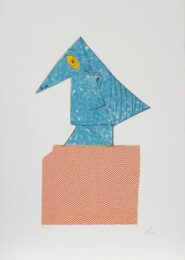

1924-2003
Born in Milan, Italy, in 1924, Enrico Baj was an artist of his time. His early career was shaped by the horrors of World War Two and the threat of nuclear war in the 1950s. Often at odds with the military-style of government that Italy was under at the time, his works had a radical political and social edge. Although he came from a wealthy family, he subscribed to anarchism and left Italy in 1944 so he wouldn’t be conscripted to take part in the Second World War. He was an originator of the Arte Nuclearia genre, which used art to criticise the military leadership seemingly taking the world towards a nuclear apocalypse.
A unique and versatile creator, Baj worked in a variety of formats, including print, collage and sculpture. He was also a writer. His primary inspiration was the expressionists of the generation that had preceded him, including Picasso and Matisse. He was also influenced by da Vinci. His works slotted into the Dada and surrealist cannon. Baj continued to create fiery, political statements with his works his whole life, including a set of paintings made as a rebuff to the election of Silvio Berlusconi during his later years. Baj died in Vergiate, Italy, in 2003.